Flowers that attract bees – 12 of the prettiest varieties
Growing flowers that attract bees will make your garden more pollinator-friendly


Adding flowers that attract bees to your garden is an easy way to make your plot more environmentally friendly and is something we should all be considering.
Something to note when adding flowers that attract bees to your backyard ideas is that you need flowers that produce both a lot of nectar and pollen. Unlike when attracting butterflies, you'll need flowers that produce both pollen and nectar, which bees need – the first offers a source of protein and the latter, a source of sugar. It is also important to ensure that you have a wide variety of flower bed ideas to attract as many different bee species as possible. With many of us wanting to be more eco conscious and self sufficient, beekeeping for beginners has seen a surge in popularity over the last decade, and it is easy to see why. There are so many different bees and identifying different types of bees and what to plant to attract them can be beneficial.
'Different pollinators require different shapes of flowers and some will only visit to feed on particular blooms and plants. In general, however, single, open flowers, such as old-fashioned cottage garden plants, are best to give easy access, and ideally planted in drifts and placed in a sunny, sheltered spot,' says Period Living garden expert Leigh Clapp.
Flowers that attract bees
If you are planning a new border in your yard, it is definitely worth improving your local eco-system and wildlife garden ideas by planting flowers that attract bees to a garden. You can do this, whether you are searching for front yard flower bed ideas, whether you are planning a cut flower garden, or simply planting a flower bed.
1. Flowers that attract bees in winter
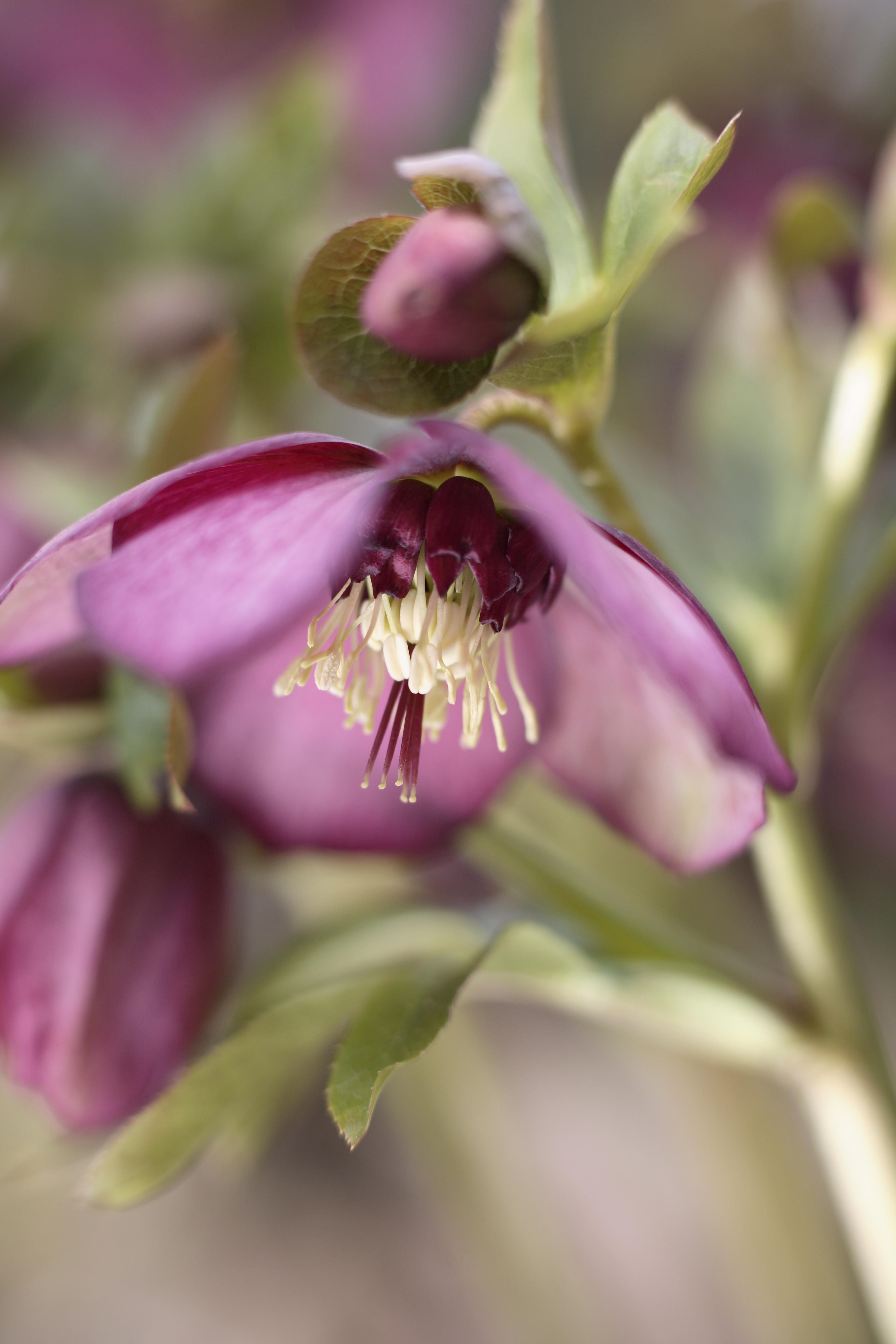
Flowering throughout winter and early-spring hellebores are a valuable addition to your winter garden ideas. During this period very few plants are in bloom and as such there are very few flowers that attract bees, this makes adding flowers all the more important.
Growing in USDA zones 4 to 8, hellebores are a highly versatile bloom that is not only a beautiful addition but also a favorite for pollinators. They are also one of the best winter plants for pots and borders making hellebores ideal for container gardening ideas.
Available in a range of colors from reds and plums through to greens and whites, they are a stunning addition to a flower garden and the single flowered varieties are a great source of pollen and nectar – a must for adding to your eco-friendly garden ideas.
Design expertise in your inbox – from inspiring decorating ideas and beautiful celebrity homes to practical gardening advice and shopping round-ups.
Furthermore, since hellebores are perennials, you don't have to worry about getting out and gardening in the cold winter weather. If you want to add a hellebore to your garden, then make sure you know how to grow hellebores before you get started.
2. Spring flowers that attract bees

Even rock gardens or small space can incorporate flowers that attract bees. ‘You don’t need much space, even a window box or container can help, as long as it has the right kinds of flowers,’ says Darryl Cox, senior science and policy officer at the Bumblebee Conservation Trust.
Primroses are a great choice for rockeries and window boxes. As well as providing a beautiful pop of color throughout late-winter and spring, they are also a great choice of flowers for pollinators. With single blooms and easy to access nectar and pollen, they are essential flowers that attract bees. As if this wasn't enough benefit, primroses are also extremely easy to grow and highly resistant to pests.
3. Flowers that attract bees in summer

When it comes to choosing from all the flowers that attract bees, foxgloves are a classic choice. 'A valuable source of pollen, especially attractive to long-tongued bees, and with a range of colors, from pinks and whites to apricots and yellows, drifts of foxgloves grace a wildlife-friendly garden,' says Leigh Clapp.
'Plant foxgloves in spring or autumn when the soil is warm and moist to encourage roots,' continues Leigh. 'Alternatively, seed collected from the pods can be sown straight away or keep in a cool dry place and sow in a tray to grow on and then plant out in spring.'
If you're looking to add foxgloves, then it is essential that you know how to grow foxgloves as there are both biennial and perennial varieties which will need different care.
If you are growing delphiniums, these are another favorite of bees and other pollinators
4. Flowers that attract bees in fall
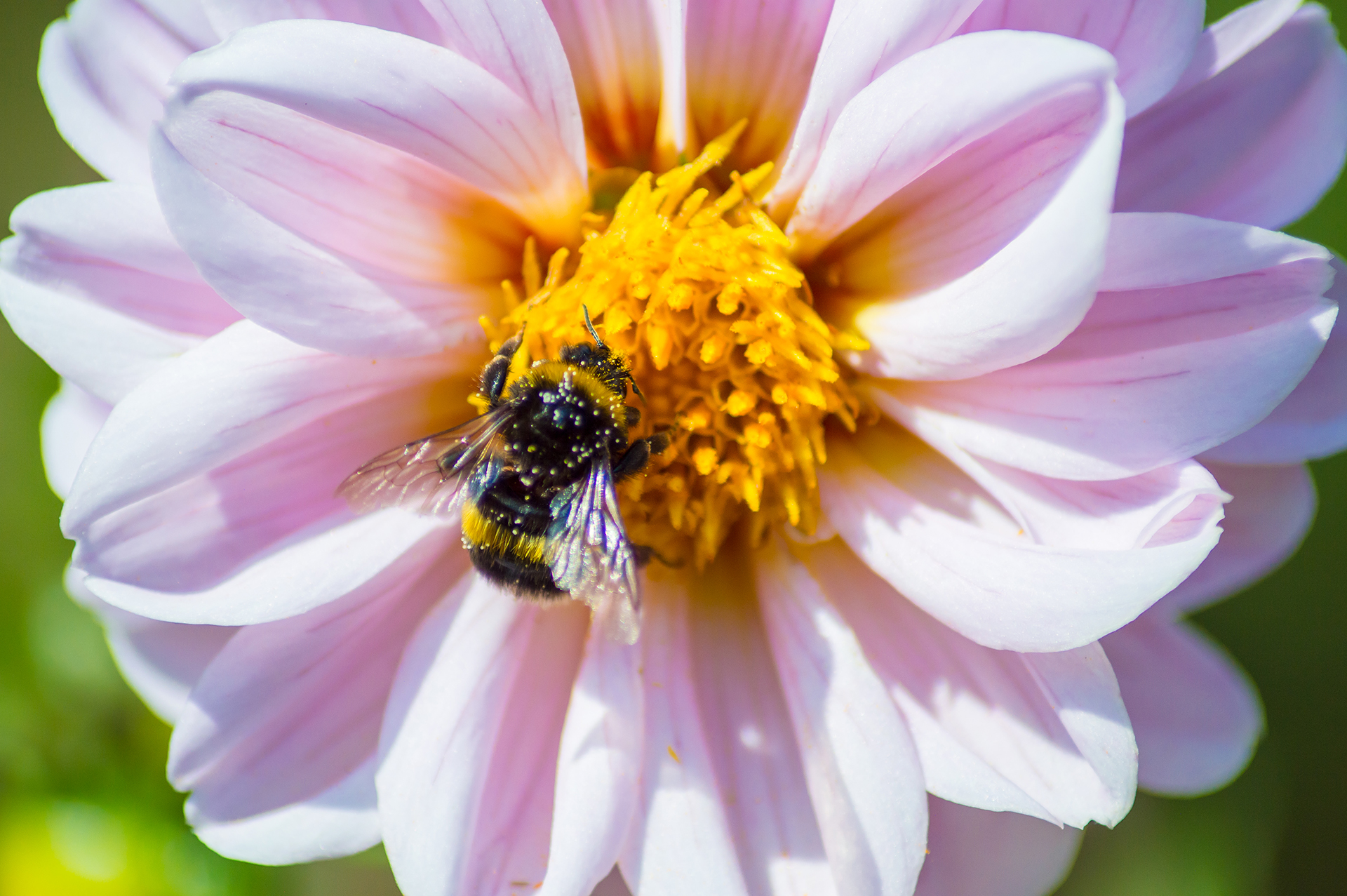
Dahlias have seen a resurgence in popularity in recent years. There are lots of different varieties of dahlia from the simple but beautiful single dahlia through to the statement pompon varieties.
However, not all dahlias are equal in their ability to attract bees, in fact it is only the single, collarette varieties and some cactus flowers that attract bees to your garden. Collarette dahlias have exposed centers which make them easy for bees to pollinate, while the centers of pompon and larger dinner-plate varieties often are more difficult access.
Learn how to grow dahlias from tubers and add these stunning flowers to your garden. It is also important to know how to overwinter dahlias so that you can enjoy these beautiful blooms year after year.
5. Shade flowers that attract bees

Dicentra are loved for their adorable heart-shaped blooms and they are also a favorite of bees. Also known as bleeding hearts, these flowers are particularly popular with bumblebees, whose long tongues and weight help them to access the pollen and nectar.
Flowering from late spring to early summer, dicentra can be planted in a wide range of garden zones from 3 through to 9. They also thrive in a woodland setting, making them a great addition to shade garden ideas. Dicentra are also one of the best flowers that attract bees for cottage gardens.
6. Scented flowers that attract bees
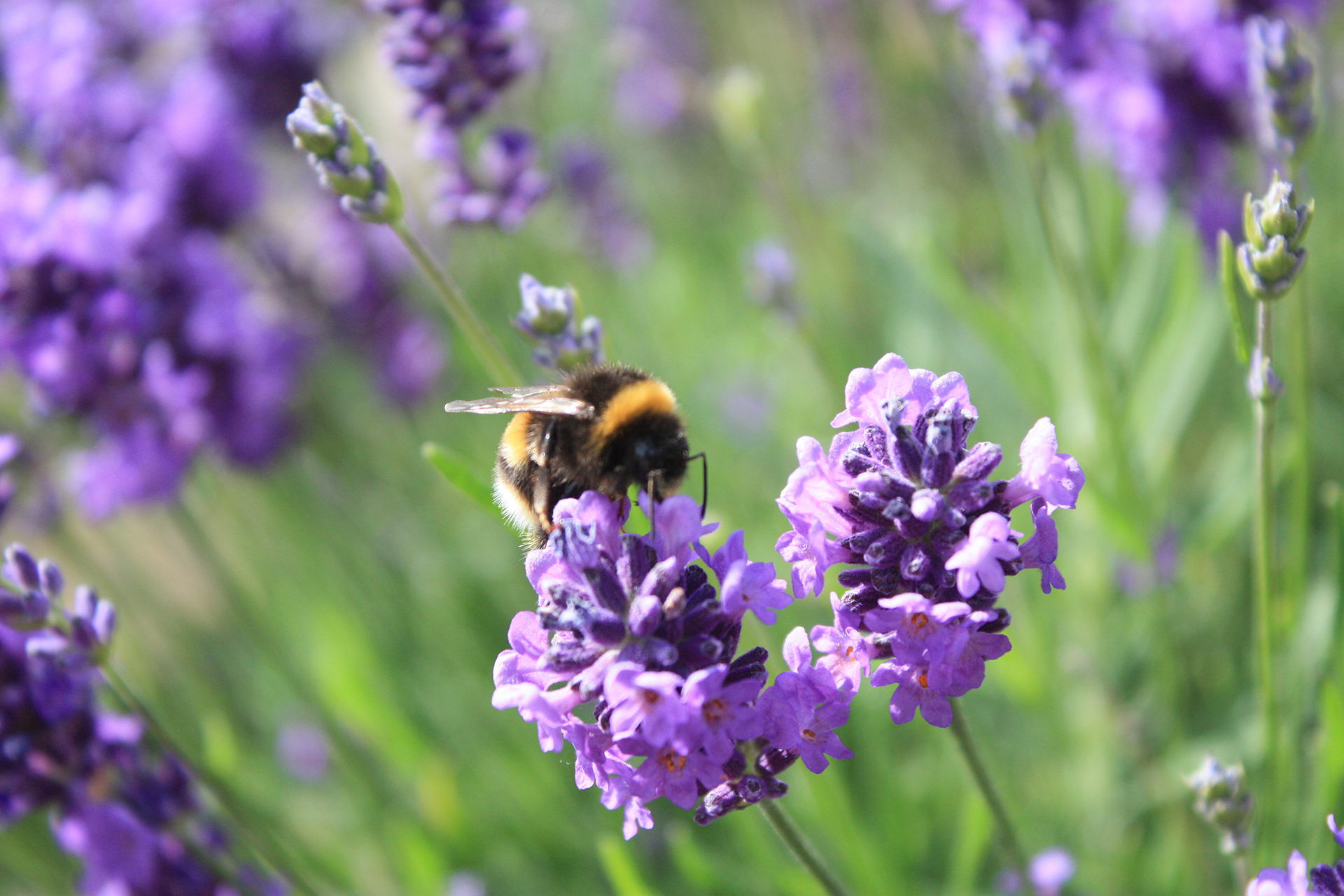
Lavender is a favorite of both homeowners planning a dry garden or Mediterranean gardens, and pollinators. Lavender's beautifully scented blooms attract bees to its nectar rich flowers and throughout the summer months can be heard buzzing with activity. Hardy in USDA zones 5a to 9a, lavender will already be in many gardeners' plots; however, you can never have too many lavender shrubs in your border. If you are thinking of adding a lavender plant to your garden, find out how to grow lavender, and then make sure you know how to prune lavender to help keep it looking its best.
‘Which flowers are the best for pollinators is an area of intense research, and it is important to take all lists with a pinch of salt as they are so selective, and can give the wrong impression that there are only a few good plants when in fact there are many,’ says plantswoman Sarah Raven. ‘As a general rule, it is the blue, mauve and purple spectrum of plants, which are richest for nectar.’
7. Flowering bulbs that attract bees

Planting bulbs is one of the easiest ways to add flowers that attract bees into your garden. From early-flowering snowdrops and crocuses through to daffodils and tulips, these blooms are all popular with a wide range pollinators including bees.
Growing flowers from bulbs is also a highly cost-effective way to grow flowers that attract bees. A bag of bulbs is a fraction of the cost of buying an established plant, plus they come back year-after-year, simply plant once and every year your garden will have an abundance of flowers that attract bees.
If you're wondering where to start with adding bulbs to your garden, these are some of the best spring bulbs. Plus learn how to plant tulip bulbs and how to plant daffodils and you'll be well on your way to filling your garden with flowers that attract bees.
8. Statement flowers that attract bees

Sunflowers are a cheery bloom that will add a smile to even the greyest day. A row of sunflowers planted along a fence will also have a transformative effect on the wellbeing of bees, who will hop from flower to flower and feed on the nectar and pollen.
Unlike flowers like dahlias and roses, sunflowers have an interesting secret. 'A single sunflower is not actually one flower, but hundreds. Hundreds of mini flowers housed in one super-structure that we know as the sunflower,' explains Ashely Densham from the University of Melbourne. As a result, from a single sunflower, you are offering bees a world of nectar and pollen. This makes sunflowers one of the most cost and space efficient ways to attract and feed bees.
Discover how to grow sunflowers, to introduce these flowers that attract bees into your garden.
9. Hardy flowers that attract bees

If you're in search of low-maintenance, easy to grow flowers that attract bees, then sedum is your answer.
Sedum, specifically upright sedum – also known as as Hylotelephium – are characterised by their succulent-like, waxy leaves and the sea of tiny pink flowers that bloom in fall. It is this cloud of pink flowers that attract bees into your garden, offering them plenty of nectar and pollen. They can provide food well into fall, before the time comes to cut back sedum for winter.
Sedum are some of the best drought-resistant plants and they are praised for the fact that they can thrive even when neglected, forgiving of bad soil and harsh sun. For this reason they are also a great addition to rock garden ideas which can often lack flowers that attract bees.
10. Climbing flowers that attract bees
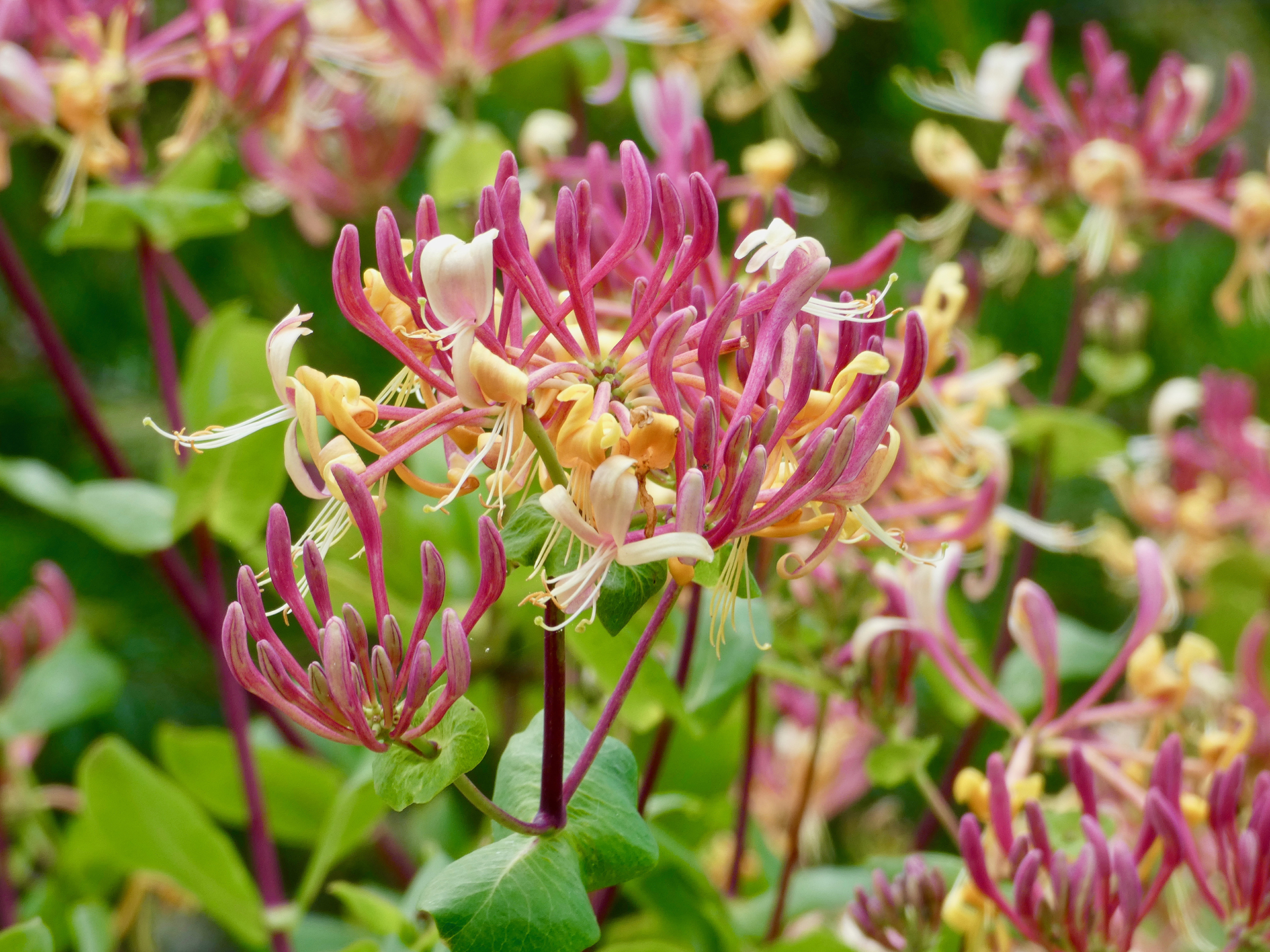
One of the best fast-growing flowering vines, honeysuckles are also brilliant flowers that attract bees. Whether trained up a trellis or pergola – there are lots of different pergola ideas and trellis ideas that would work well – honeysuckles' lateral growth makes them a great choice for vertical garden ideas and will help you maximize the amount of flowers that attract bees in a small yard, too.
'The summer-flowering climber honeysuckle is a great choice for flowers that attract bees, but don't overlook shrubby honeysuckles too as its an excellent winter-flowering shrub that can provide much needed pollen and nectar throughout the colder months,' says Helen Bostock.
11. Early winter flowers that attract bees
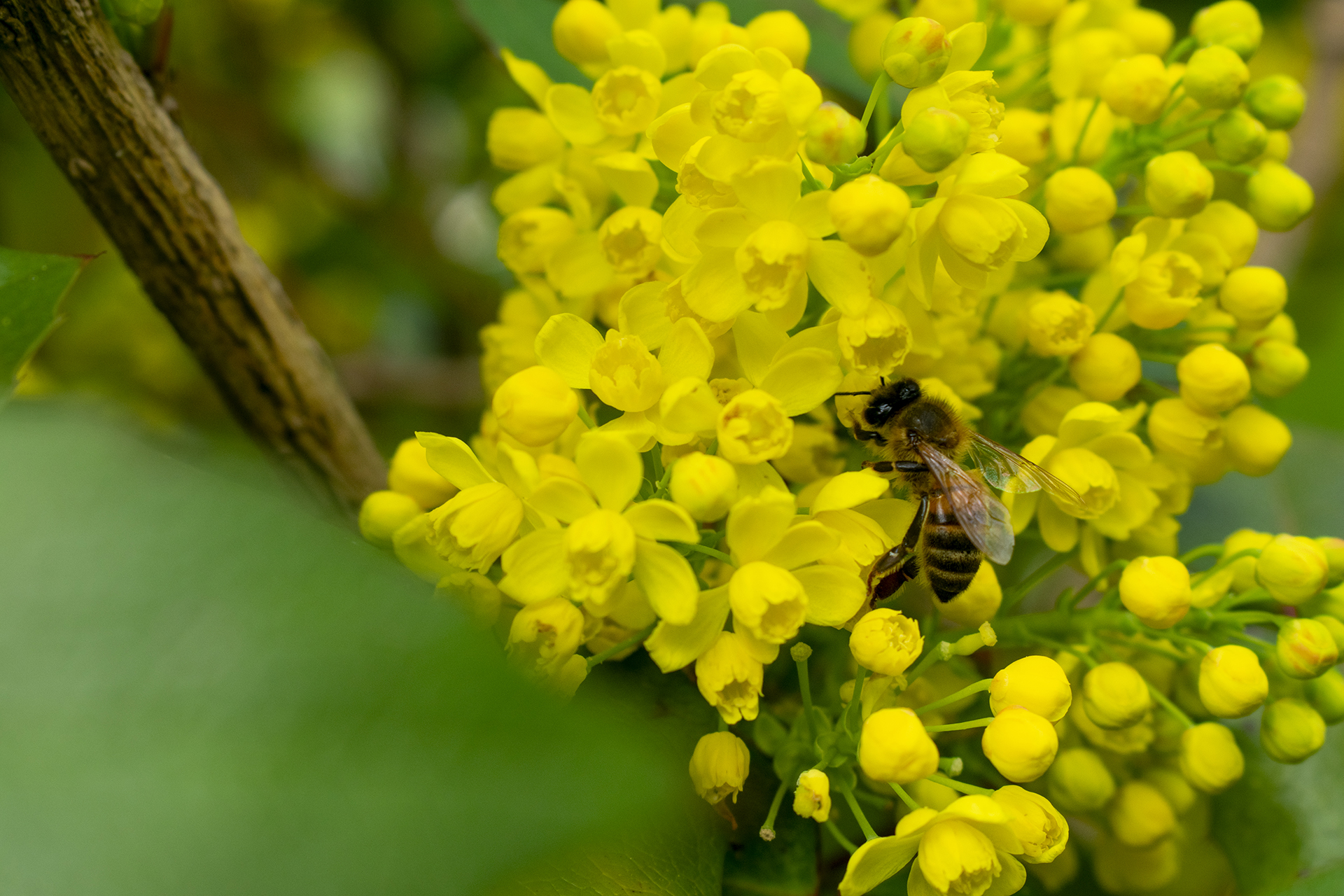
Don’t forget the potential of your front yard for adding flowers that attract bees – flowering shrubs are a great choice, and lots of the best flowering shrubs for the front of the house will also attract bees.
‘The best options for in front of the house are relatively slow growing varieties that are evergreen or have a lively seasonal color,’ says Robert Bell, principal at Bell Design. One such plant is mahonia, slow-growing, it is great for adding to your front yard, especially as part of front yard cottage garden ideas. However, its growth pattern isn't what attracts the bees, throughout early winter, mahonia erupts in an array of yellow flowers offering bees with a valuable source of food during this more desolate time of the year.
As climate change continues to impact our eco-systems, there has been increasing evidence of bees waking up from hibernation earlier and earlier, says Helen Bostock. This makes having flowers available all-year round all the more important.
12. High nectar flowers that attract bees
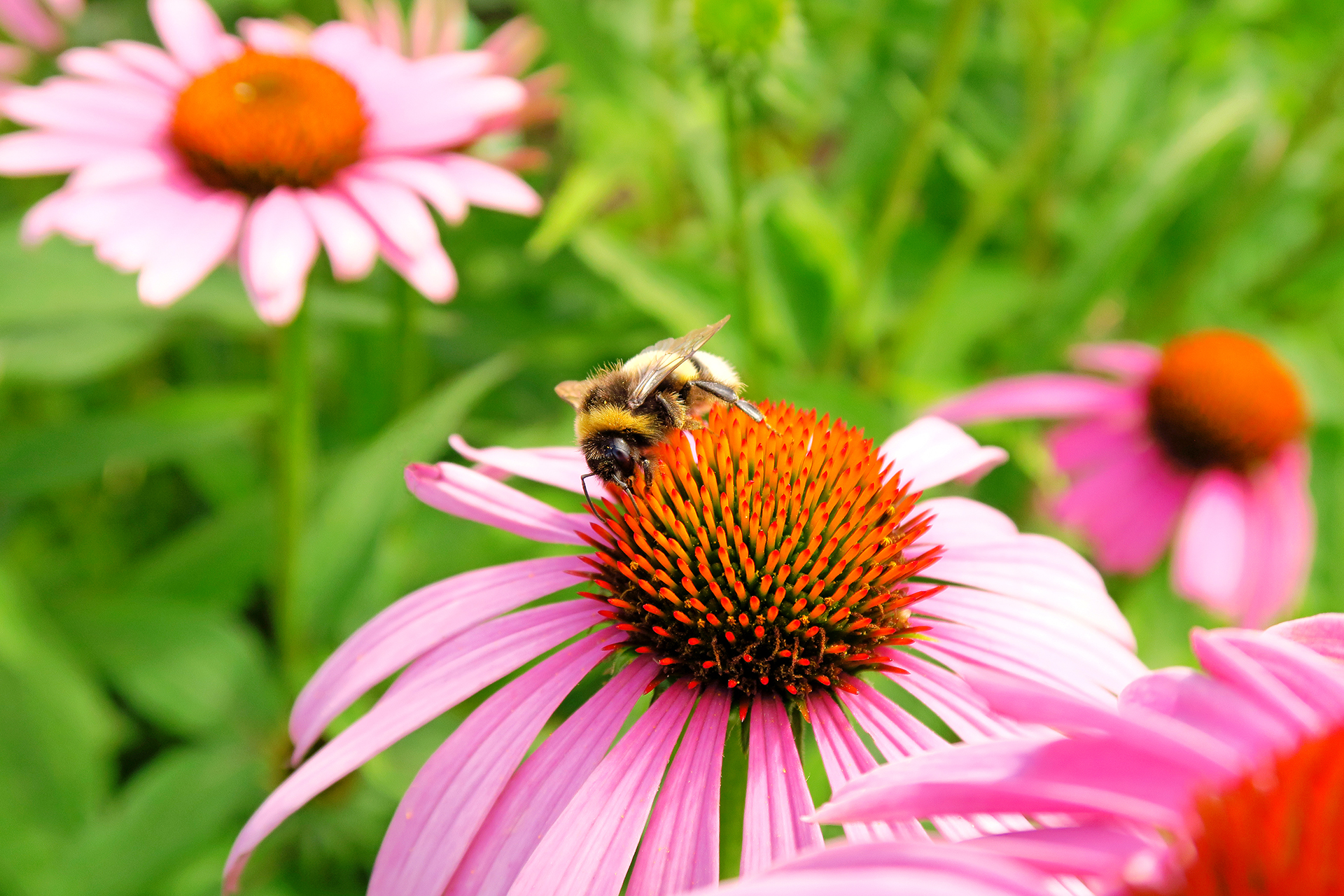
Echinacea are a character bloom, characterized by their large cone shape with a prominent center and downward facing petals. While you might best know echinacea as a great plant for immunity gardens, they are also beneficial for bees and other pollinators.
'A North American gardening staple with large, composite summertime flowers. Their central flowerhead is like a breadbasket for all sorts of pollinators, which will buzz about the plant all the way through to early fall,' says Tammy Sons, founder of TN Nurserys.
Why plant flowers that attract bees?
Bees are essential pollinators and a valuable part of our eco-system. However, like so many species they are under threat from habitat loss, pesticides and climate change. This is why it is vital to plant flowers that attract bees.
'Without bees, we would be unable to produce much of the food we take for granted – from everyday staples such as broccoli and apples through to seasonal treats like strawberries, a third of total food production is dependent on insect pollination,' says Barnaby Coupe, land use policy manager for The Wildlife Trusts, 'They need our help, and by growing bee-friendly plants and providing "wilder" areas in our gardens we can help provide the food and shelter they need to thrive.'
While some wildlife garden ideas seem complicated or possibly feel like a compromise to your garden design, adding flowers that attract bees to your garden is one of the easiest ways to make your plot more wildlife-friendly.
‘Anyone with a good range of flowering plants in their garden is probably already doing pretty well at catering for pollinators, but we can make it even better by planning our planting scheme so there is something in flower in any given month,’ says Helen Bostock, senior wildlife specialist at the RHS.
How do you attract bees?
The easiest way to attract bees is to add flowers that attract bees to your garden. Sunflowers, hellebores and daffodils are all good and easy to grow options. The more flowers in your garden, the more bees you will attract as well as other pollinators.
‘If you want to encourage bumblebees to nest, try leaving a corner to grow wild,’ suggests Darryl Cox.
Do roses attract bees?
Yes, roses do attract bees, however, only some species of roses will be beneficial and attractive to bees. When selecting a bee-friendly rose, you firstly need to consider how easy it would be for a bee to access the center – where the pollen is located.
Double-petalled varieties are practically impenetrable, especially to smaller bees – while single or semi-double flowers such as dog rose or sweet briar, where you can see the center of the flower, are a much better choice.
It's also worth noting that roses only produce pollen, not nectar, so only provide bees with one of their two food types. Consider adding other flowers that attract bees to your garden alongside your favorite roses in your rose garden ideas.
Roses have the added benefit of being popular plants for leaf-cutter bees who will, as their name suggests, cut through parts of the leaves and use it to line their nests.

Having graduated with a first class degree in English Literature, Holly started her career as a features writer and sub-editor at Period Living magazine, Homes & Gardens' sister title. Working on Period Living brought with it insight into the complexities of owning and caring for period homes, from interior decorating through to choosing the right windows and the challenges of extending. This has led to a passion for traditional interiors, particularly the country-look. Writing for the Homes & Gardens website as a content editor, alongside regular features for Period Living and Country Homes & Interiors magazines, has enabled her to broaden her writing to incorporate her interests in gardening, wildlife and nature.